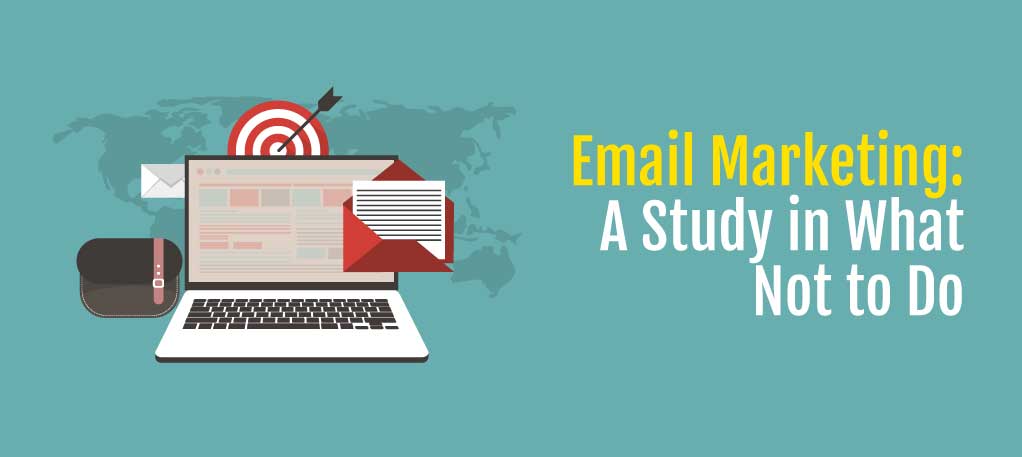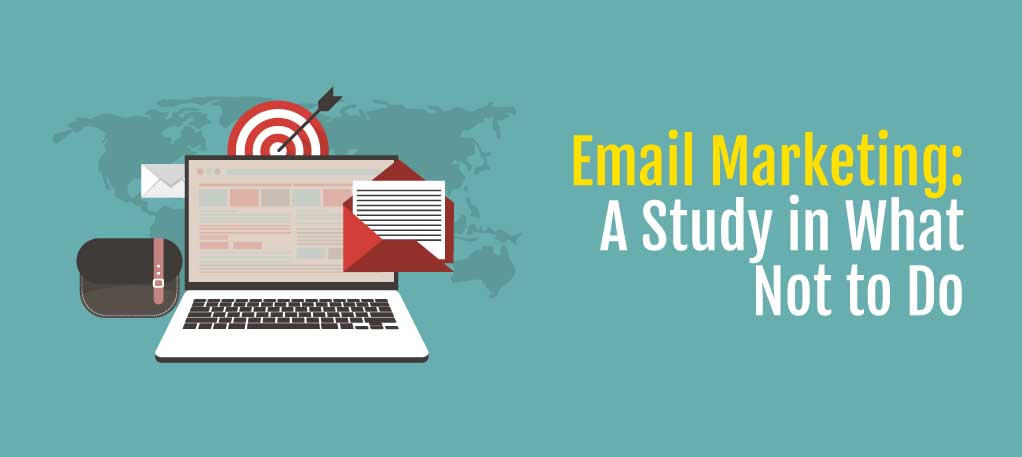Email Marketing: A Study in What Not to Do
 by Skyler Holobach
by Skyler Holobach
Recently, I took my car to the dealership to get my window fixed. As part of this transaction, I gave my email address to be contacted with a price quote and get updates about where my car is in the maintenance process. Okay, cool, I’m completely fine with that. What I was later not so fine with was being suddenly bombarded with marketing emails from that same dealership, asking me to trade in my vehicle and get the be$t deal$! Upgrade my air conditioning to Arctic Blast! Buy a new car! Then, their unsubscribe link didn’t work when I tried to unsubscribe, so I did what will inevitably cause some cringing among those reading this: I clicked to report the email as spam. That definitely could have been prevented, so in today’s post I’ll break down what went wrong and what should have been done.
WHAT WENT WRONG: GIVING OUT MY EMAIL ADDRESS WITHOUT MY CONSENT
I’ve been writing for the Pardot blog for quite some time, and I think it’s about time for a little bit of marketing tough love: Unless I explicitly sign up, I don’t want to be emailed. I don’t care if we’ve done business in the past, I don’t care if you have a $UPER AWE$OME $ALE, I’m not interested unless I explicitly tell you I’m interested. In this case, I wasn’t even made aware of what they were doing with my email address, which made me feel extra uncomfortable about the marketing emails I was suddenly subjected to. As I’ve mentioned before, one of my favorite quotes in email is “treat an inbox like an invitation to someone’s home”. This car dealership was invited in to my house for one reason, to provide me with updates. They then handed out my address to other people in their company to come traipsing by at any time, without my knowledge or consent. That wasn’t what I agreed to or was made aware of, and it’s not okay to do to someone.
WHAT SHOULD THEY HAVE DONE? ASKED!
If I’d been aware that they were going to hand my email address off to marketing, they had a chance to ask me for my permission at two points: at the point of collection or as soon as marketing got hold of my email address. It’s definitely best to clarify why my address is being collected at the point at which I’m talking to you directly, but that may not always be the case (especially if you’re getting a list from a trade show). In that instance, permission can still be solicited on the marketing side. It’s as simple as sending an email saying “Hey, we got your information from XYZ, we thought you’d be interested in our product. Please click here to opt in to receive future marketing emails from us”. That’s a great, well documented way to get consent from your prospects, in addition to being a tremendous way to make sure you’re only expending marketing effort on people who legitimately want your email.
WHAT WENT WRONG: FAILURE TO SEGMENT
Okay, so they never should have been sending me email without my express consent, we’ve covered that pretty thoroughly. However, on top of that, they had no idea what I’m actually interested in receiving. Suddenly, I was receiving mass emails about everything- air conditioning upgrades, trade in deals, offers on new cars, you name it, I was suddenly receiving all of it. If they’d collected more information at the point of sale to determine what my interests were, they could have sent me relevant emails, instead of crushing me under their clear lack of understanding and segmentation about who I was as a prospect.
WHAT SHOULD THEY HAVE DONE? ASKED! (YES, AGAIN)
“What are you interested in receiving” is an excellent question to ask at the point of collection for an email. Let people tell you exactly what emails they want to receive, instead of having to add them to every list you have and hope one of those emails is vaguely relevant and desired. Consider this: you wouldn’t buy a birthday present for a friend without knowing what they’re interested in, would you? Same goes for email, do a little bit of homework and find out what that person actually wants, so you can send them email that matters to them.
WHAT WENT WRONG: BROKEN UNSUBSCRIBE LINK
This one’s pretty important, and could possibly be a CAN-SPAM violation, as prospects have no way of opting out of receiving email. I clicked to unsubscribe and received an error page, and the email was sent from a no-reply email address, so there was no way for me to opt out of receiving the annoying email I never wanted.
WHAT SHOULD THEY HAVE DONE? TESTED!
A common saying in crafting and in woodworking definitely applies here: measure twice, cut once. Test your email send as a live send with a working unsubscribe link and make sure you are able to actually unsubscribe. The point is to be absolutely sure, without any doubt, that your live send will work as expected. Don’t make the mistake of sending out an email and leaving it to chance. The unsubscribe link is one of the most important parts of your email send, so you definitely want to make sure it works. If not, it could lead to people reporting your email as spam, which can cause major reputation damage.
Lava is an authorised Salesforce Partner in Malaysia and has more than a decade of experience in cloud solutions which includes marketing automation, CRM implementation, change management, and consultation. We pride ourselves in not just being a CRM partner but in also understanding the needs of our customers and taking their business to the next level

